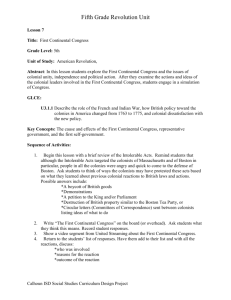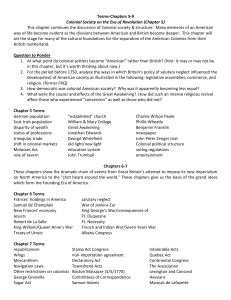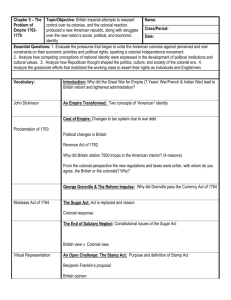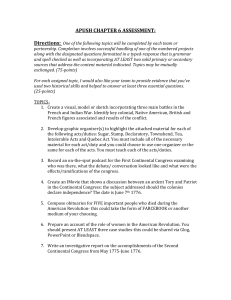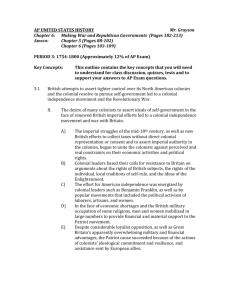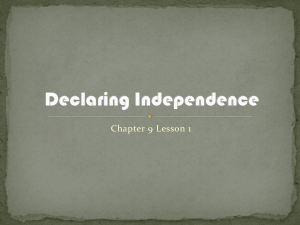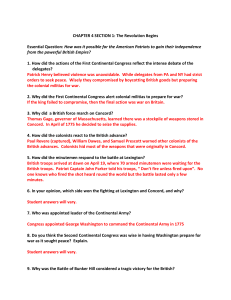Guided Reading & Analysis: The American Revolution and
advertisement
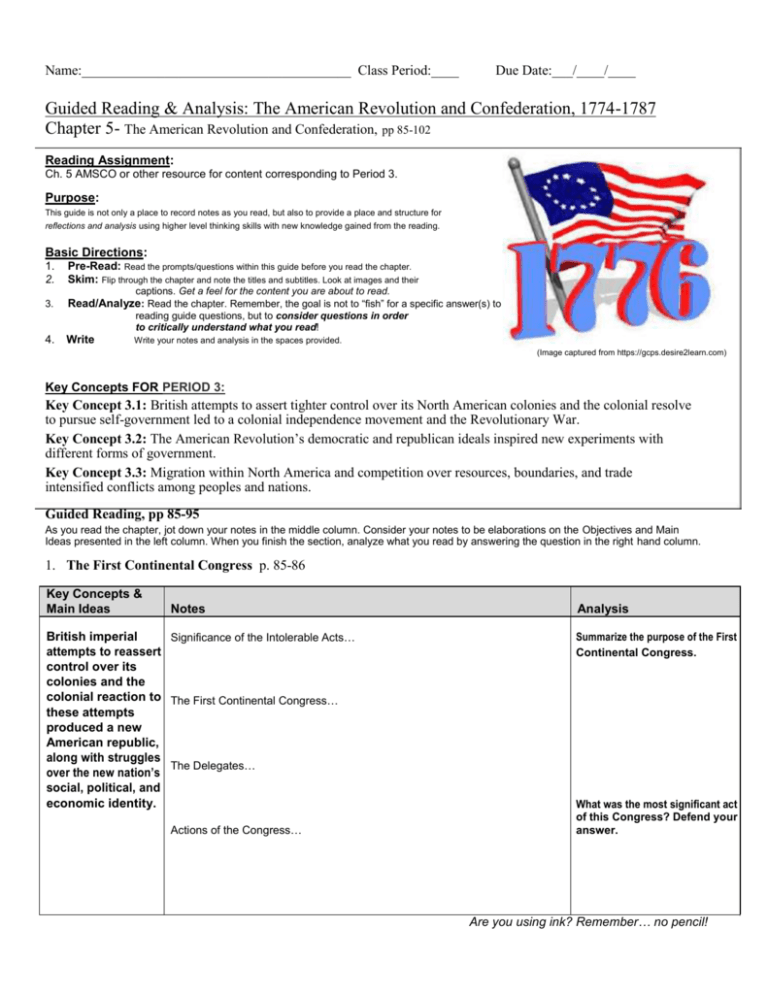
Name:_______________________________________ Class Period:____ Due Date:___/____/____ Guided Reading & Analysis: The American Revolution and Confederation, 1774-1787 Chapter 5- The American Revolution and Confederation, pp 85-102 Reading Assignment: Ch. 5 AMSCO or other resource for content corresponding to Period 3. Purpose: This guide is not only a place to record notes as you read, but also to provide a place and structure for reflections and analysis using higher level thinking skills with new knowledge gained from the reading. Basic Directions: 1. 2. Pre-Read: Read the prompts/questions within this guide before you read the chapter. Skim: Flip through the chapter and note the titles and subtitles. Look at images and their 3. Read/Analyze: Read the chapter. Remember, the goal is not to “fish” for a specific answer(s) to captions. Get a feel for the content you are about to read. reading guide questions, but to consider questions in order to critically understand what you read! 4. Write Write your notes and analysis in the spaces provided. (Image captured from https://gcps.desire2learn.com) Key Concepts FOR PERIOD 3: Key Concept 3.1: British attempts to assert tighter control over its North American colonies and the colonial resolve to pursue self-government led to a colonial independence movement and the Revolutionary War. Key Concept 3.2: The American Revolution’s democratic and republican ideals inspired new experiments with different forms of government. Key Concept 3.3: Migration within North America and competition over resources, boundaries, and trade intensified conflicts among peoples and nations. Guided Reading, pp 85-95 As you read the chapter, jot down your notes in the middle column. Consider your notes to be elaborations on the Objectives and Main Ideas presented in the left column. When you finish the section, analyze what you read by answering the question in the right hand column. 1. The First Continental Congress p. 85-86 Key Concepts & Main Ideas Notes British imperial Significance of the Intolerable Acts… attempts to reassert control over its colonies and the colonial reaction to The First Continental Congress… these attempts produced a new American republic, along with struggles The Delegates… over the new nation’s social, political, and economic identity. Actions of the Congress… Analysis Summarize the purpose of the First Continental Congress. What was the most significant act of this Congress? Defend your answer. Are you using ink? Remember… no pencil! 2. Fighting Begins, pp 86-87 Key Concepts & Main Ideas Notes During and after the imperial struggles of the mid-18th century, new pressures began to unite the British colonies against perceived and real constraints on their economic activities and political rights, sparking a colonial independence movement and war with Britain. Fighting Begins… Analysis What was the chief reason for colonial discontent just prior to the first shots? Lexington and Concord… Explain how the fighting between British troops and colonists illustrated the cultural conflict that had evolved. Bunker Hill… 3. The Second Continental Congress, pp 87-88 Key Concepts & Notes Main Ideas The resulting independence movement was fueled by established colonial elites, as well as by grassroots movements that included newly mobilized laborers, artisans, and women, and rested on arguments over the rights of British subjects, the rights of the individual, and the ideas of the Enlightenment. The colonists’ belief in the superiority of republican selfgovernment based on the natural rights of the people found its clearest American expression in Thomas Paine’s Common Sense and in the Declaration of Independence. Second Continental Congress… Analysis What was the most significant accomplishment of the Second Continental Congress? Defend your answer. Military Actions… Peace Efforts… What was the most powerful argument by Thomas Paine for independence? Explain your reasoning. Thomas Paine’s Argument for Independence… The Declaration of Independence… 4. The Revolutionary War, pp 88-91 Key Concepts & Main Ideas Notes Despite considerable loyalist opposition, as well as Great Britain’s apparently overwhelming military and financial advantages, the patriot cause succeeded because of the colonists’ greater familiarity with the land, their resilient military and political leadership, their ideological commitment, and their support from European allies. The Revolutionary War… Analysis Explain how the American Revolution was essentially a Civil War. Patriots…. What was a common motivation for African Americans and American Indians fighting in the Revolution? African Americans…. Why is the Battle of Saratoga the turning point of the war? Loyalists…. Tories… List 4 important reasons why the British lost the war. 1. 2. American Indians… 3. 4. Initial American Losses and Hardships… List 4 important provisions of the Treaty of Paris, 1783. 1. Alliance with France… 2. 3. 4. Victory… 5. Organization of New Governments pp 91-93 Key Concepts & Main Ideas Notes During the 18th century, new ideas about politics and society led to debates about religion and governance, and ultimately inspired experiments with new governmental structures. Organization of New Governments… Many new state constitutions and the national Articles of Confederation, reflecting republican fears of both centralized power and excessive popular influence, placed power in the hands of the legislative branch and maintained property qualifications for voting and citizenship. List of Rights… The policies of the United States that encouraged western migration and the orderly incorporation of new territories into the nation both extended republican institutions and intensified conflicts among American Indians and Europeans in the trans-Appalachian West. Analysis Explain how the following Colonial Era events influenced the creation of new state constitutions: House of Burgesses: State Governments… Roger Williams Founds Rhode Island: Separation of Powers… Voting… Office Holding… John Locke and other Enlightenment thinkers theorize on the relationship between man and government: The Articles of Confederation… Ratification… The First Great Awakening: Structure of Government… Powers… Accomplishments… What was the most significant accomplishment of the AOC? Explain your reasoning. Problems with the Articles… What was the most significant weakness of the AOC? Explain your reasoning. 6. Social Change, pp 93-94 Key Concepts & Main Ideas Notes Social Change… While the new governments continued to limit rights to some groups, ideas promoting selfgovernment and personal liberty reverberated around the world. The constitutional framers postponed a solution to the problems of slavery and the slave trade, setting the stage for recurring conflicts over these issues in later years. New voices for national identity challenged tendencies to cling to regional identities, contributing to the emergence of distinctly American cultural expressions. Analysis Explain how close the new nation came to ending slavery. Abolition of Church and State… Women… Explain how close the new nation came to gender equality. Slavery… Which one came closer, racial or gender equality? 7. Historical Perspectives, p. 95 Opposing Viewpoints on the “Radical” nature of the Revolution-NOTES Analysis-Context Crane Brinton… American Revolution Local Context: Differences between American Revolution and the French and Russian Revolutions… Broad Context: Divergent interpretations of the Sons of Liberty… Similarities of Revolution to the post WWII rebellions in Africa and Asia… Similarities between Revolution and the post WWII rebellions in Cuba and Vietnam… Other Context: Section 2: HIPP+ Historical Context: Intended Audience: Author’s Purpose: Author’s Point of View: +Other Context (Similar in Kind, In a Different Time) Historical Context for map (map image captured from mapssite.blogspot.com) Significant changes in North America following the Treaty of Paris 1783:
